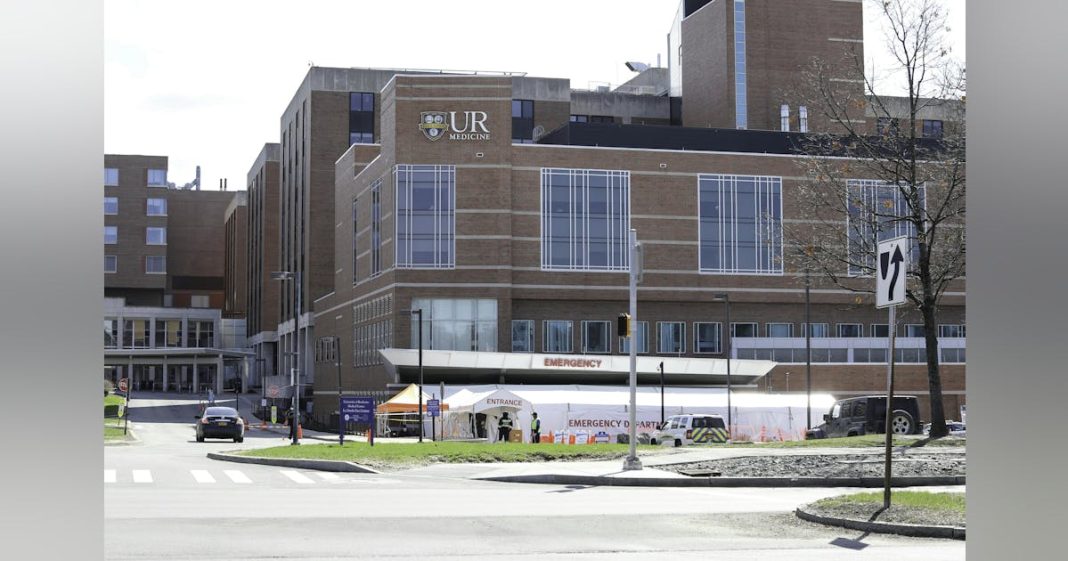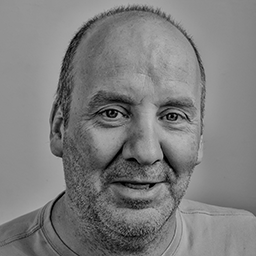In early 2021, the University of Rochester Medical Center (URMC) in upstate New York began an enterprise-wide roll-out of point-of-care ultrasound (POCUS) devices across 64 departments. Surgeon Michael Rotondo, M.D., CEO of the University of Rochester Medical Faculty Group and senior vice president of URMC, recently spoke with Healthcare Innovation about the goals of the project and the work still to be done.
URMC partnered with a company called Butterfly to launch an enterprise-wide ultrasound program designed to improve access to imaging and enhance clinical workflows. To date, URMC has deployed approximately 1,000 Butterfly iQ devices across 64 academic departments and clinical programs, integrated with Butterfly’s Compass workflow software. URMC plans to scale the program to 2,500 devices by 2026.
Healthcare Innovation: Could talk first about some of the advantages of point-of-care ultrasound technology? How does it change how procedures or diagnoses are done in the health system?
Rotondo: Health systems have primarily used cart-based ultrasound technology. You have an ultrasound machine that’s on a cart you roll to the patient’s bedside. It’s usually unit-based. So if you’re working in the emergency department, it sits the emergency department. If you’re working in the ICU, it sits in the ICU. It’s been for medical intensivists who take care of acute illness. There are some limitations to that, not the least of which is it’s not always accessible. You could be in another location and have to go to a different unit to bring that device in. Most importantly, the images that were acquired would be stored primarily in that cart ultrasound, not up in the cloud and not easily transportable to the electronic health record. Also, primary care physician offices don’t have ultrasound capabilities whatsoever.
The Butterfly iQ Plus is a handheld device. They came up with a a chip-based technology, so they’re able to generate those ultrasound waves on a tiny little chip, and that allows the device itself to fit into your pocket. The imaging device is your phone, so through a Bluetooth interface, the ultrasound goes right to your phone. They created a cloud-based solution that allows those images to be immediately uploaded into the cloud and then into the electronic health record.
Because of the portability of it, because of the capability of capturing those images in the cloud, because of the ability to put them in electronic health record and to use it pretty much anywhere — in the home care setting, in in the nursing home setting, in the primary care offices and the surgeons’ offices, up on the general care units in the hospital, it changes the game dramatically.
HCI: So then almost every clinician who works in those fields that you just described could have one in their pocket, basically?
Rotondo: Exactly. Since 2022 we’ve deployed just under 1,000 of these devices across our enterprise. We have 2,200, physicians that are in our multispecialty group.
We also deploy to our medical students, because we think that this is the stethoscope of the future. Everyone will have this in their pocket. As time goes on, it’ll become basically standard of care to be able to do imaging and some diagnosis at the time of your physical examination. For a physical examination a physician is using their ears, their eyes and their hands to envision what anatomic structures look like, to think what the pathology might be. Now you’ve got imaging in your hands that helps you do that at the next level. Some artificial intelligence that’s built into the probe can not only help you identify what that structure is, but maybe what’s not normal about that structure, what the potential pathology might be. So it’s really incredibly interesting technology, which we’re still learning a lot about.
HCI: How widespread is this in health systems across the country? Is URMC a pioneer in this or is it rolling out in a lot of places?
Rotondo: We’re on the leading edge of this because of the relationship with Butterfly. Their leadership reached out. They were looking for academic medical centers that might have interest in working with them. We happen to have two things: the University of Rochester Health Lab, which is a think tank, sort of incubator/accelerator that I helped establish 10 years ago where we look at brand new technologies. Also, our radiologists had been doing research in in ultrasound in the Department of Orthopedics. So we decided to work with them on a wide-scale deployment, but also to study that deployment. What works? What doesn’t? What are the challenges in trying to change physician practice? How does it benefit patients? What does it do for quality?
HCI: That was going to be my next question. Is there a way to study the impact on quality of care?
Rotondo: Previously, you really didn’t know how utlrasound was being used. Now we have image capture in almost 80% of the studies. We have an image; we have a report, and we can look at the image and the conclusions, just as you would with any x-ray or any imaging, and determine if something was missed, if it’s accurate or not. So it’s given us the ability to have a robust quality program that otherwise just didn’t exist.
HCI: What about impact on cost? If someone was looking at this from the payers’ perspective, are there all of a sudden a lot more ultrasounds getting billed for?
Rotondo: That’s a great question, and I think the jury’s still out in that, but I can tell you that our charge capture now is up 116%, so we are now capturing charges for these studies and then trying to design a way to determine if this actually leads to more studies. Because after you do a handheld ultrasound and you get a specific impression, does it just drive more diagnostic tests, or do you have enough information in that particular use case to go right to therapy and right to treatment?
So there are two parts to looking at impact — timeliness and the appropriateness. Is the timeliness such that you’re making the diagnosis earlier and moving immediately to care, or is it that you were having a test that creates greater sensitivity and leads to unnecessary tests down the line or inappropriate care? I think the jury is still out on that. I will say that’s the kind of thing that we’ve been very careful about. One of the things we’ve not done is say use this to bill for a lot more services. We have been focusing very clearly on what are the key use cases, in abdominal pain and shortness of breath, in chest pain, and a whole variety of presenting conditions where it helps our primary care physicians help patients. It helps our home care nurses help patients. It helps nurses on the floor help patients. So I think it’s an exceptionally important question. It’s the one that really requires additional study.
HCI: You mentioned the integration with the EHR as being valuable. Did that require a lot of customization on Butterfly’s part or URMC’s?
Rotondo: The fact that they created the cloud-based solution and had it as far advanced as as they did is just exceptional work on their part. I mean, it really is a game changer. This also allows any cart-based device’s images to be uploaded to the to the cloud.
But it did still require some additional work. Specifically, to get the providers’ iPhones secure to be used as a device through which an image could then be uploaded to the record. Both we and the company underestimated how much work that would be, but we got through it. So the answer is we’ve been learning together. On the one hand, they brought the cloud-based portion of the technology way down the line. On the other hand, we both learned that there were still some barriers that we had to get through, but we were able to find our way through them.
HCI: Besides studying the impact on clinical quality, you’re also studying workflows and adoption. Any lessons learned so far?
Rotondo: I think the results are about what one would expect. We’ve had early adopters who now wouldn’t practice without it. And then there’s an evolving group that’s in the middle. And then some folks who see it as an additional thing they have to learn and do, and don’t necessarily see the utility of that. We want to be respectful of what people can and cannot do. We only have 175 primary care physicians in our group, and they’re across all age groups. We have skewed this more toward our younger working groups and our students, because we know that they’re much more oriented toward technology, and they will end up actually driving the change.
HCI: Do you have a governance committee established around this project?
Rotondo: We have good practice governance committees in general through the medical faculty group governance structure. Whenever we introduce new technology into the health system, it doesn’t just happen because somebody wants it. We bring it through a process and make sure it’s fully vetted, so that it’s safe. We thought very clearly about what use cases will be applicable, and then we go from there. You’ve got to have governance policy. Then you’ve got to do monitoring and make certain that you’re doing it in a safe and responsible way.
HCI: Is there still work to be done going forward on this?
Rotondo: We’ve been doing the deployments sequentially, rather than just throw 3,000 devices out there and see what happens. We’re learning as we go. So we anticipate that this rollout will continue for the next year into 2026. As we’re doing this across various use groups, we are studying the use cases as well, and then using that cumulative experience to benefit new people that we bring into the program.
It’s going to be interesting to see what happens with the movement of hospital-at-home across the country, of more people being cared for in the home than ever. The ultrasound on a chip, regardless of of whose device it is, even though it’s proprietary for Butterfly at the moment, I think it’s going to be essential in home imaging.
HCI: When we began the conversation, you mentioned its use in the hospital setting. Was there a group you started with first to pilot it?
Rotondo: We actually started with primary care. We thought it was pretty innovative to start with primary care, not to jump into where there might be resistance in the emergency department and cardiology. They’ve been really accustomed to using cart-based technology. We started with new users who don’t do imaging, and it’s really fascinating how, as you would expect, some people took to it right away, and others less so.
HCI: In the primary care setting, are there a couple of main things that they would use it for?
Rotondo: The use case that comes to mind is congestive heart failure, where you can identify fluid around the lungs. You can identify specific changes within the lung that occur as a result of congestive heart failure. Another one would be right upper quadrant pain looking for gallbladder problems. You can see thickening of the gallbladder or stones in the gallbladder. It really can get you to diagnose them, rather than run the patient off to x-ray or try to schedule a study. In some cases, you can do immediate referral to the specialist. Doing the modeling around that and what happens on the cost side is complicated, though, and it’s going to take more time for us to really understand that.







